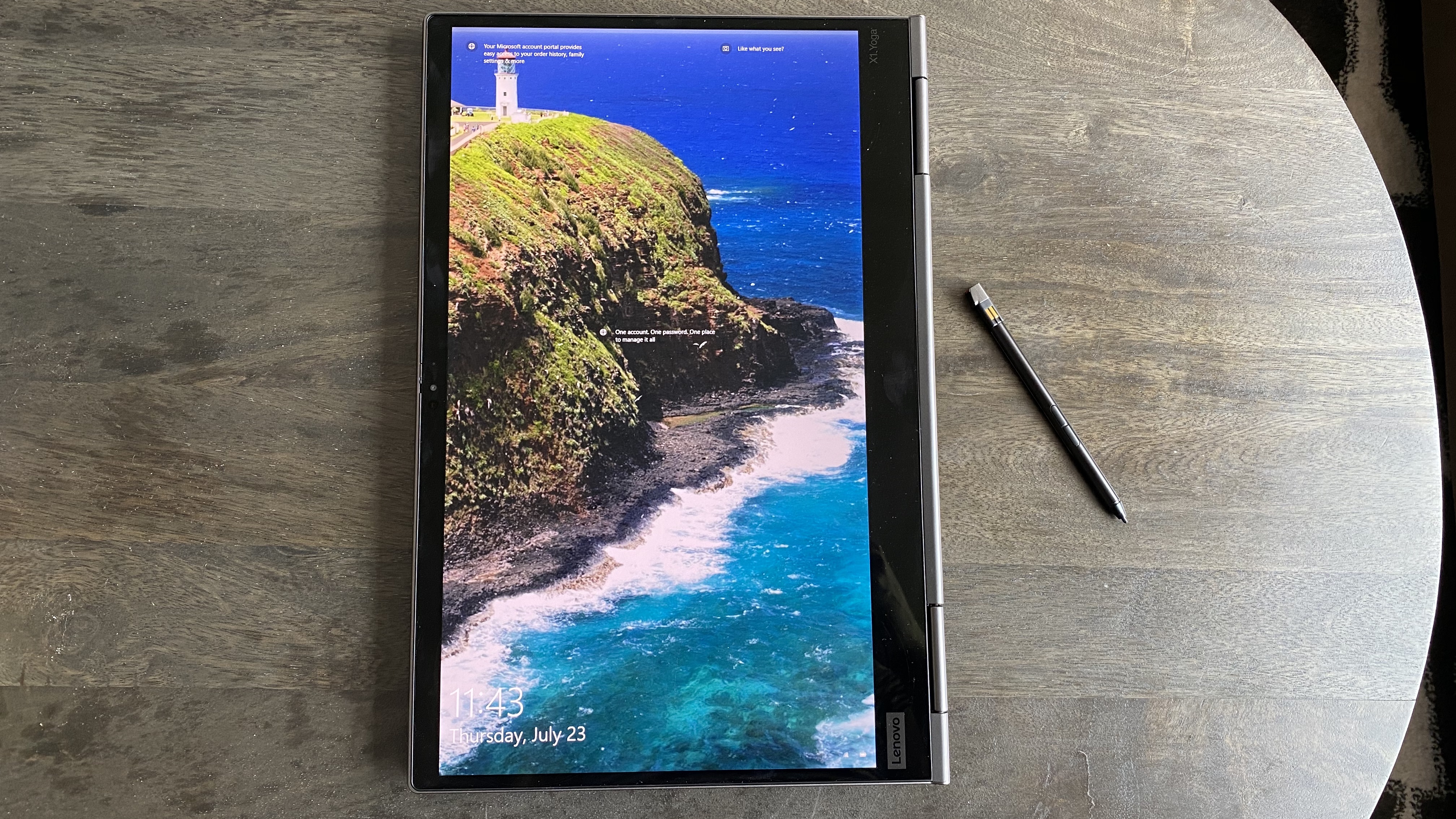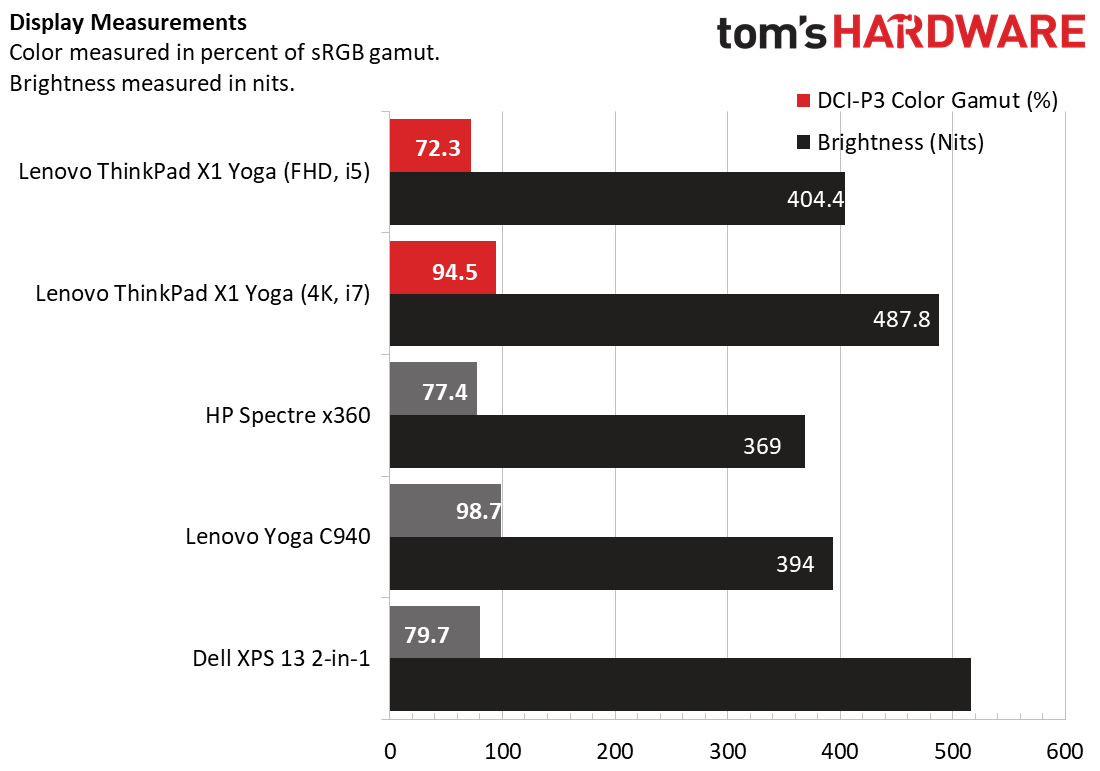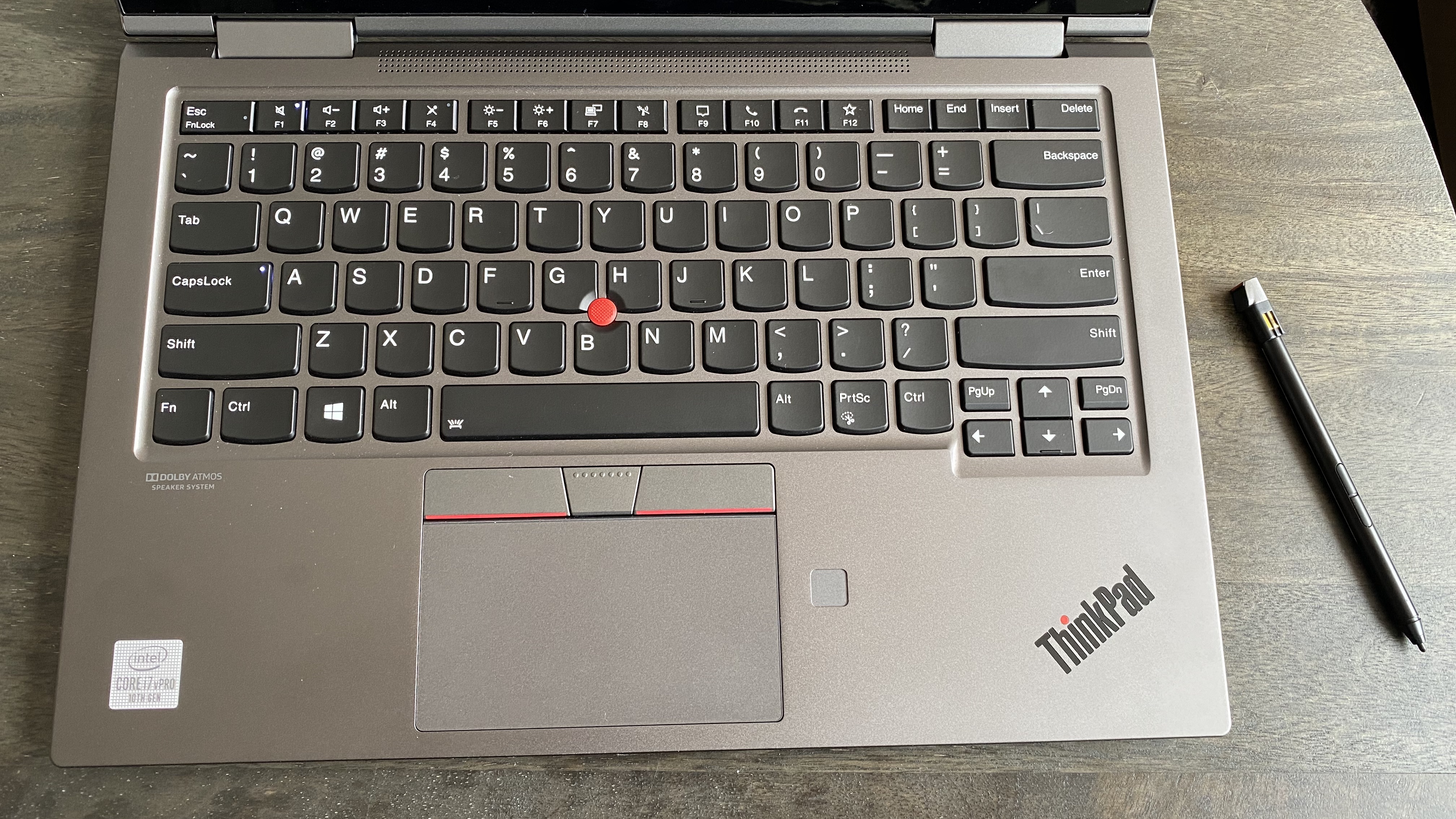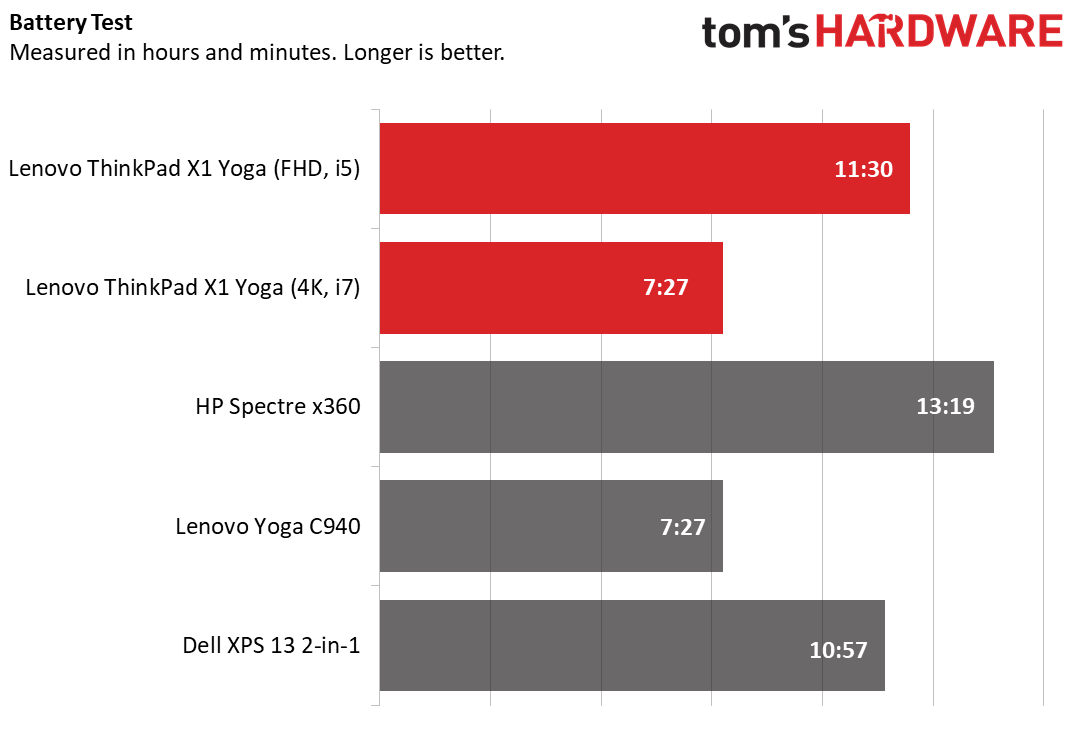Tom's Hardware Verdict
The ThinkPad X1 Yoga Gen 5 is a powerful convertible with a speedy SSD and plenty of convenience, but it’s more suited to enthusiasts and businesses than the average consumer.
Pros
- +
Included stylus
- +
Comfortable keyboard
- +
Trackpoint nub
- +
Speedy SSD
- +
Bright display
Cons
- -
Pricey overall
- -
RAM can’t be upgraded
- -
Small SSD for price
Why you can trust Tom's Hardware
The ThinkPad X1 Yoga was the first ThinkPad to have an all-metal chassis when its 4th generation came out last year, cementing its place as a premium convertible where branding is just as important as performance. That trend continues in the 5th generation ThinkPad X1 Yoga ($1,440.12 to start, $1,670 and $2,107 as tested), which updates the line with a wider selection of Intel’s 10th Gen Comet Lake processors than were available on gen 4 models, as well as Wi-Fi 6 connectivity and two new VoIP function keys. It’s also got slightly longer battery life than its predecessor, and carries over the typical ThinkPad keyboard, trackpoint and stylus.
Even at its current price (which is a "sale," though Lenovo.com always has some kind of discount), the ThinkPad X1 Yoga is more expensive than consumer-targeted competitors such as the HP Spectre x360 and Dell XPS 13 2-in-1. However, with the X1 Yoga, you get business-friendly features such as MIL-SPEC-tested durability and optional vPro support.
Lenovo ThinkPad X1 Yoga (Gen 5) Specs
| CPU | Intel Core i5-10310U/Intel Core i7-10610U |
|---|---|
| Graphics | Intel UHD Integrated Graphics |
| Memory | 16GB DDR3 1064 MHz |
| Storage | 256/512GB |
| Display | 14 inch 1920 x 1080 IPS touchscreen/ 3840 x 2160 IPS touchscreen |
| Networking | 802.11 a/b/g Wi-Fi 6, Bluetooth 5.0 |
| Ports | 2x USB Type-C, 2x USB Type-A, HDMI Out, 1x Lenovo dock slot, 3.5mm Headphone/Mic jack |
| Camera | 720p Webcam |
| Battery | 51Wh |
| Power Adapter | 65W |
| Operating System | Windows 10 Pro |
| Dimensions(WxDxH) | 12.7 x 8.5 x 0.6 inches |
| Weight | 2.8 pounds |
| Price (as configured) | $1,670/$2107 |
Design of ThinkPad X1 Yoga (Gen 5)

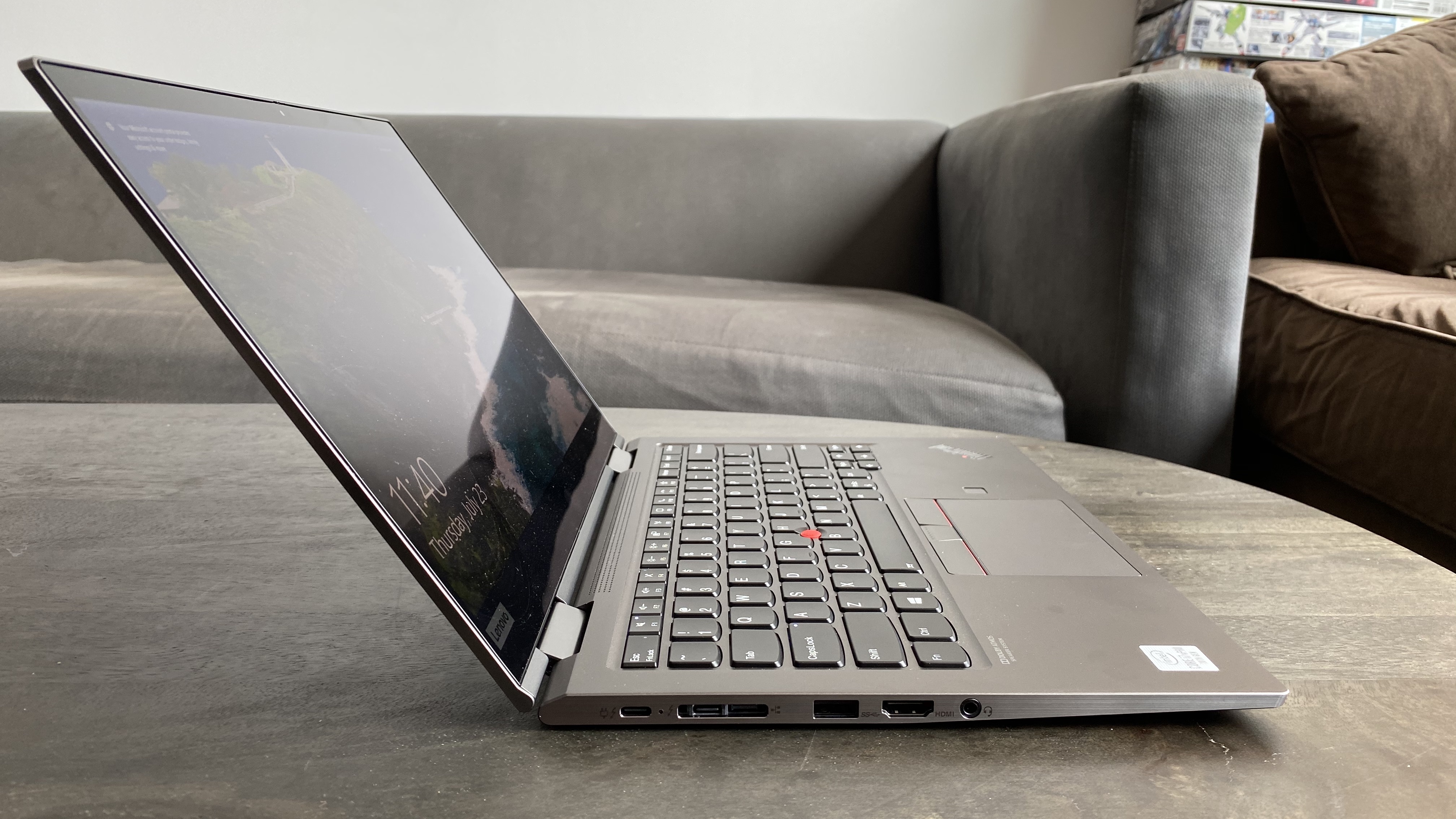

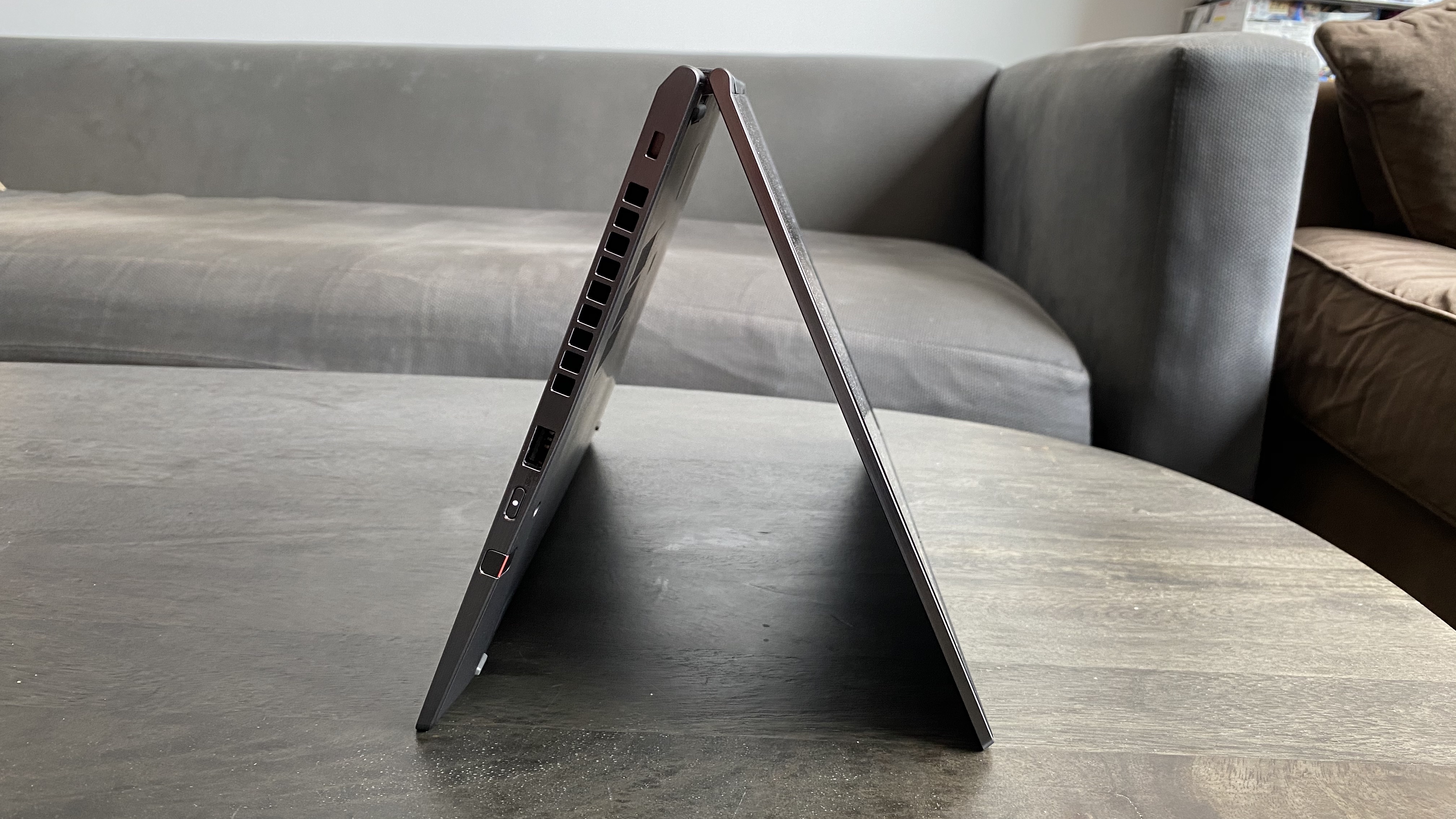
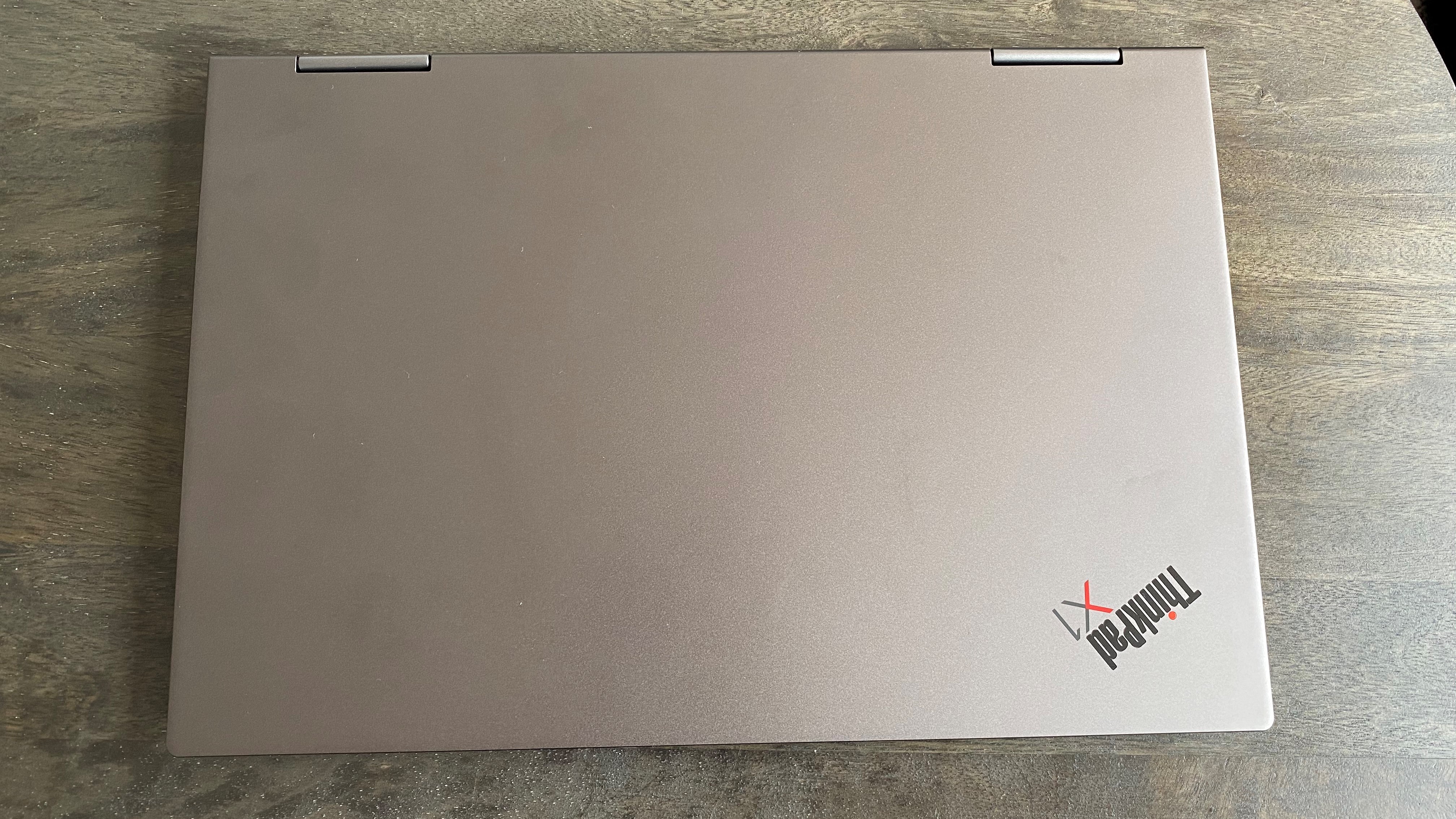

When it comes to looks, the ThinkPad X1 Yoga is essentially the same as other ThinkPad thin-and-lights like the minimal and businesslike X1 Carbon, though Lenovo’s swapped out the typical ThinkPad raven black for a gunmetal gray. That’s not necessarily new for the company -- Lenovo’s offered gray and silver color schemes for a while. But the decision to put gray front and center here probably stems from the X1 Yoga’s all-metal aluminum chassis, which debuted as a first for the company on last year’s X1 Yoga models.
Aside from those two differences, the X1 Yoga remains largely faithful to the usual ThinkPad playbook. The power button is on the machine’s right side rather than inside the laptop, there’s a stylus tucked away right next to it, and the distinctive red trackpoint nub sits at the center of the X1 Yoga’s keyboard while a fingerprint sensor sits below it. The touchscreen display also folds over to transform the laptop into a tablet, and the upward firing speakers and non-retractable keyboard return from last year’s model.
The X1 Yoga Gen 5 comes in both FHD and 4K models, each of which are 12.7 x 8.5 x 0.6 inches. That’s on par with competitors like last year’s HP Spectre x360 13, which is 12.1 x 7.7 x 0.7 inches, as well as the Dell XPS 13 2-in-1, which is slightly smaller with a size of 11.7 x 8.2 x 0.5 inches. It’s also almost dead even with Lenovo’s own consumer-oriented Yoga C940, which has dimensions of 12.6 x 8.5 x 0.6 inches.
At 2.8 pounds, the X1 Yoga is also in a tight race with competitors like the Spectre (2.7 pounds) and the XPS (2.9 pounds). It does shave a few ounces off of the Yoga C940’s 3 pounds, however.
On the left side, the ports include a single USB Type-A connector, two USB Type-C connectors, one HDMI port, one 3.5mm headphone/mic combo jack, the power cable and one proprietary Ethernet connector (though you’ll need a dongle to use it). The right side only has a single port, which is a USB Type-A connector. This is likely due to the placement of the power button and stylus, which fill out the right side’s features. There’s also a vent and a lock slot here.
The left side’s Ethernet connector and the USB Type-C slot that sits right next to it can also work together to support a Lenovo dock.
Productivity Performance of ThinkPad X1 Yoga (Gen 5)
We tested two different configurations of the Lenovo ThinkPad X1 Yoga (Gen 5), with our FHD unit coming equipped with a more mid-range Intel Core i5-10310U and our 4K unit carrying the more premium i7-10610U.
Regardless of which configuration you choose, the X1 Yoga is powerful though not quite as speedy as some rival systems we tested, which pack Intel Core i7-1065G7 processors. Competitors also all use 16GB of RAM, aside from the Spectre. While you can buy the X1 Yoga with just 8GB of RAM, we recommend going for the 16GB that was present in our testing units, as it’s easy for modern PCs to exceed 8GB of memory with heavy multitasking or even just browsing across a lot of tabs at once.
For us, 16GB proved to be plenty when browsing, as we were able to simultaneously open 30 Chrome tabs on both of our test units, including three FHD YouTube videos and one 1080p @ 60 fps Twitch stream, without any loss in speed. The fans did start whirring once the videos started playing, though.
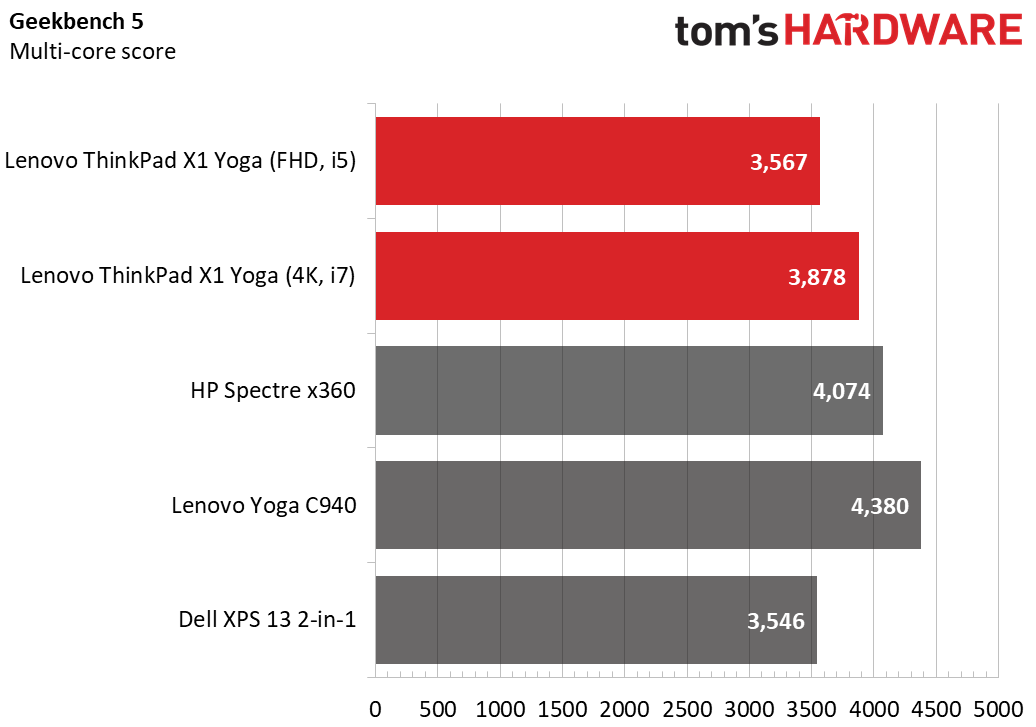
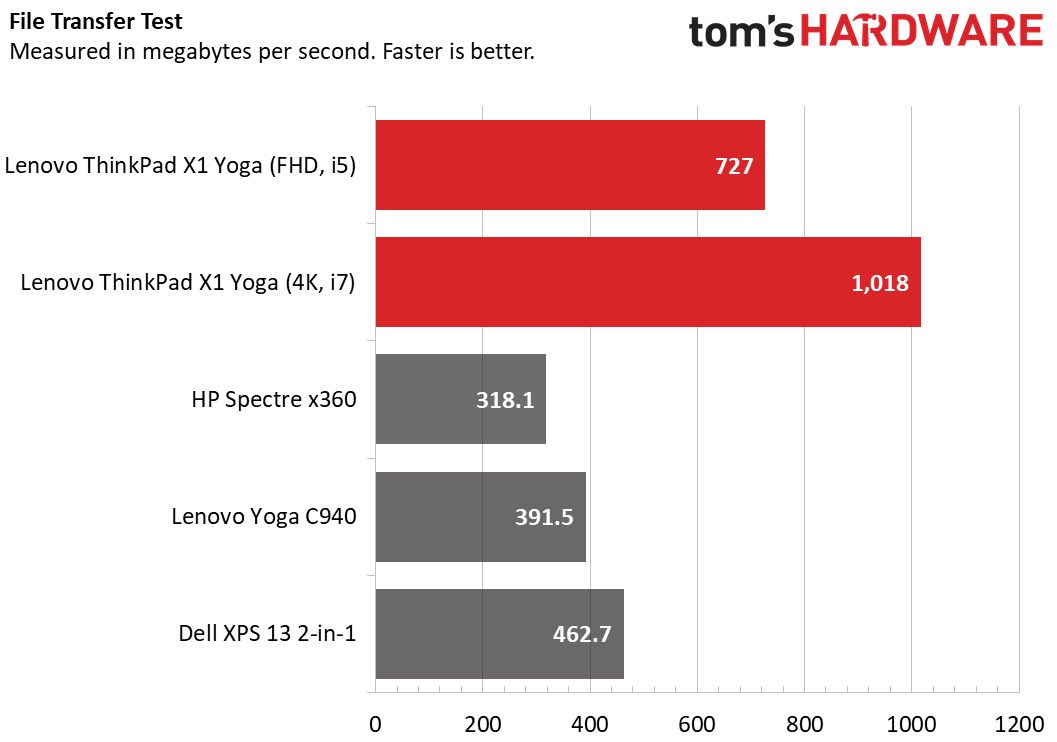
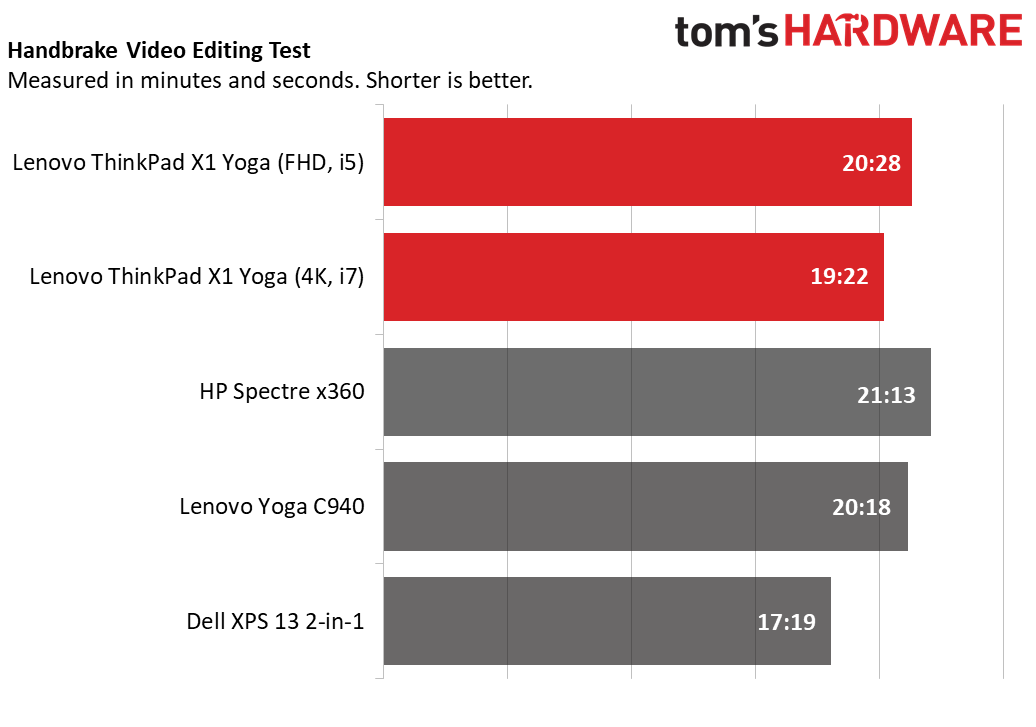
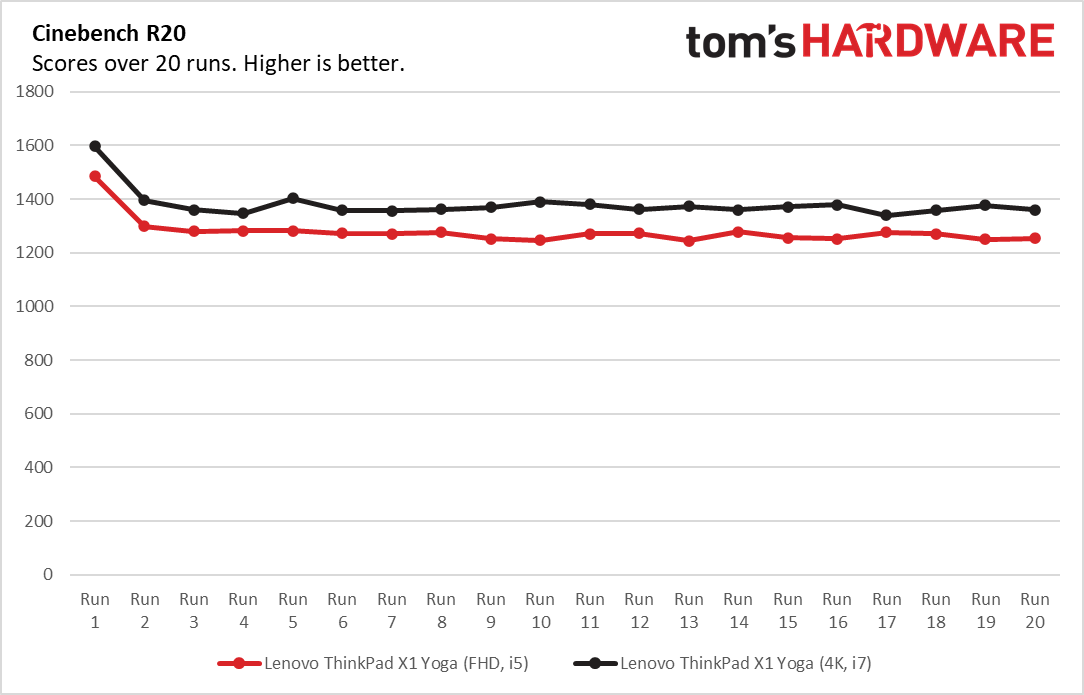
On Geekbench 5.0, which measures overall performance, both X1 Yogas ended up towards the middle of the pack. The highest scorers here were the Yoga C940 with a score of 4,830 and the Spectre with a score of 4,074. Our 4K X1 Yoga came in shy of that with a score of 3,878, while our FHD X1 Yoga trailed behind with a score of 3,567. Both of these scores are still higher than the XPS’s 3,546.
The X1 Yogas excelled on our file transfer test, which tracks how long it takes a computer to transfer 4.97GB of files. Here, the FHD X1 Yoga achieved speeds of 727 MBps, while the 4K X1 Yoga reached 1,018 MBps. Both of these times are much faster than the X1 Yoga’s competitors. Even the XPS, the next fastest unit, only reached 462.66 MBps, while the Spectre lagged behind at 318.1 Mbps. The Yoga C940, meanwhile, was about half as fast as the FHD X1 Yoga at 391.5 MBps.
Results were generally the same across the board for our Handbrake video editing test, where we see how long it takes each computer to transcode a video from 4K (3840 x 2160) to FHD (1920 x 1080). The Core i5-powered X1 Yoga completed the task in 20:28 while the Core i7-powered X1 Yoga was slightly quicker with a time of 19:22. The Spectre and Yoga C940 each had similar results, with respective times of 21:23 and 20:18. The big outlier here was the XPS, which was faster than all of its rivals, finishing the benchmark in 17:19.
To test the X1 Yogas’ graphics, we also ran them through the Dirt 3 graphics benchmark (1080p at medium settings). Unfortunately, this is where the X1 Yogas were the weakest. Every computer we tested uses Intel Integrated graphics, with the X1 Yogas using Intel UHD Integrated graphics and all of its competitors using Intel Iris Plus. Because Iris Plus is so much better, the X1 Yogas were over a dozen frames behind rival machines. The Core i5-powered X1 Yoga had an average fps of 29 during the benchmark, while the Core i7-powered X1 Yoga only fared slightly better, with an average fps of 30.73. The Spectre and the XPS both had a 47 fps average, while the Yoga C940 was the fastest with an average fps of 55.
Get Tom's Hardware's best news and in-depth reviews, straight to your inbox.
We also stress tested both X1 Yogas by running Cinebench R20 on a loop 20 times. The average score for the Core i5-powered X1 Yoga was 1,278.58, and its average CPU clock speed and temperature were 2,497.9 Mhz and 87.7 degrees Celsius (189.86 degrees Fahrenheit), respectively. Meanwhile, the Core i7-powered X1 Yoga scored an average of 1379.83, while its average CPU clock speed was 2,867.6 Mhz and its average CPU temperature was 80.2 degrees Celsius (176.4 degrees Fahrenheit).
Display on ThinkPad X1 Yoga (Gen 5)
We tested two models of X1 Yoga, one with a 14 inch FHD IPS display and one with a 14 inch 4K IPS display. Both were bright and had great viewing angles, though suffered on color.
I tested out our FHD X1 Yoga by watching the trailer for The King of Staten Island on it. In both high and low ambient light, the picture was clearly visible from pretty much any angle, and the screen was well lit without any of the colors washing out. Still, the laptop tended to struggle in dark scenes, with shallow blacks making character outlines difficult to make out. Bright scenes also weren’t vivid, but were easy to follow.
The 4K X1 Yoga had similar brightness and viewing angles to its FHD counterpart, but its image was much more colorful and rich. I tested its screen by watching the open source 4K short film Tears of Steel, which did not suffer from the shallow blacks that were present on the FHD model and had plenty of vivid colors regardless of how dark or bright the movie got. Like its FHD cousin, it also performed well in both high and low light environments.
Our testing showed that the FHD X1 Yoga had the smallest color spectrum of any of the computers in its class, capturing just 72.3% of the DCI-P3 color spectrum. That’s below both the Spectre’s 77.4% coverage and the XPS’s 79.7% coverage. The 4K X1 Yoga fared better, recreating 94.5% of the DCI-P3 spectrum, though the Yoga C940 still pulled ahead with 98.7% coverage.
On brightness, however, both X1 Yogas were strong. The FHD X1 Yoga had an average 404.4 nits of brightness, while the 4K X1 Yoga went well beyond that with an average 487.8 nits of brightness. Both of these scores are above the Spectre’s average 369 nits of brightness and the Yoga C940’s average 394 nits of brightness. The XPS was the brightest, however, hitting an average of 516 nits of brightness.
Keyboard, Touchpad and TrackPoint of ThinkPad X1 Yoga (Gen 5)
Both of our ThinkPad X1 Yoga (Gen 5) configs have the same keyboard feel, which is to say, they both use Lenovo’s excellent ThinkPad style keyboard setup. On 10fastfingers.com, I managed between 75 - 84 words per minute, which is pretty exceptional given that my usual average is 75 words per minute. That’s probably thanks to the concave keycaps helping me easily find my place on the keyboard without needing to look.
The font is also professional and unobtrusive, and the Fn keys directly link to helpful features like brightness, sound and even VoIP call answer and hang-up functions- a welcome addition in our webcam-commute post-pandemic world. The keyboard’s backlight is a little difficult to see thanks to the opaque nature of the keycaps, but it should help in a pinch.
The traditional ThinkPad TrackPoint returns here, and though I’m not much of a trackpoint user, I found that the sensitivity wasn’t too high and that I was generally able to get it to move where I wanted without taking that much longer than I spend on the trackpad. It was also comfortable not to have to take my hands off the home row, so I could see it working extra well for those who suffer from wrist pain due to pronation or frequent repetitive movement.
The 4 x 2.3-inch precision glass trackpad was also nice and snappy, providing a smooth surface that still has enough friction for detailed cursor movement.
Audio on ThinkPad X1 Yoga (Gen 5)
The X1 Yoga is unique when compared to most laptops in that it has both downward and upward firing speakers. The downward firing speakers are on either of the computer’s sides and sit close to the user, while the upward firing speakers sit just below the laptop’s hinge. This allows the computer to evenly project sound across your entire workspace, as well as more evenly across both sides when converted into a tablet.
Listening to Lady Gaga and Ariana Grande’s “Rain on Me,” both of our models accurately recreated the song’s melody with few tinny notes, though the opening bass track was almost silent on both. Most apparent was the volume discrepancy between models, as our 4K model was noticeably louder at the same volume level than the FHD model. Both models were able to easily fill my 2-bedroom apartment with noise when pushed to the max, though the 4K model might be better if you’re looking to DJ a party and need a higher noise ceiling.
Upgradeability of Lenovo ThinkPad X1 Yoga (Gen 5)
Opening up the X1 Yoga is a simple process. To remove the bottom case, I simply loosened its five Phillip’s head screws and gently lifted it off. This gave me access to the battery, Wi-Fi chip and the PCIe M.2 SSD, though the RAM was soldered in.
There’s not much to do once you’re inside, but you can swap out the SSD for a larger one if you like. Since Lenovo charges an arm and a leg to configure your laptop with a 1TB SSD, you might prefer to buy the laptop with a 256GB model and swap it out for one of the best SSDs.


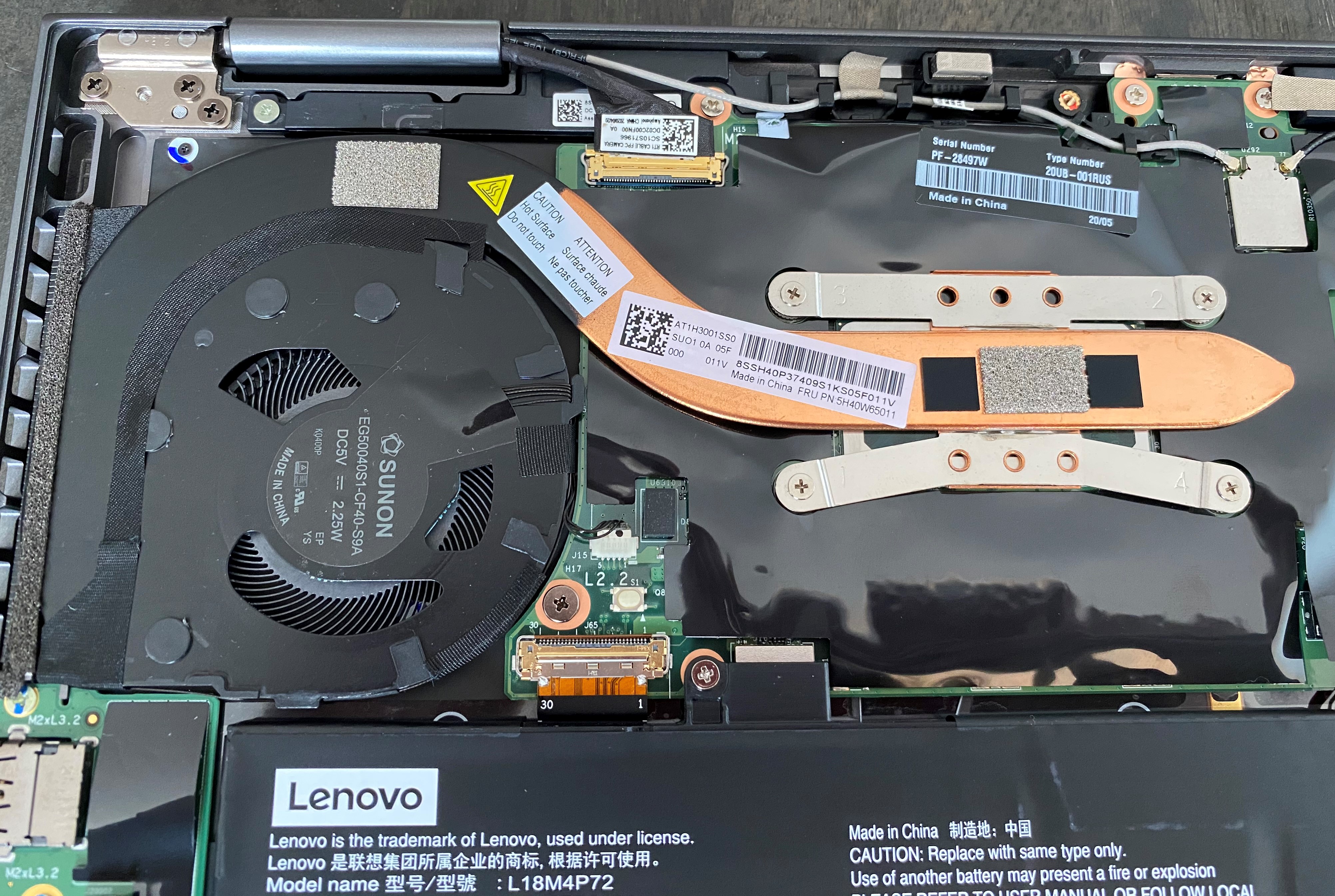
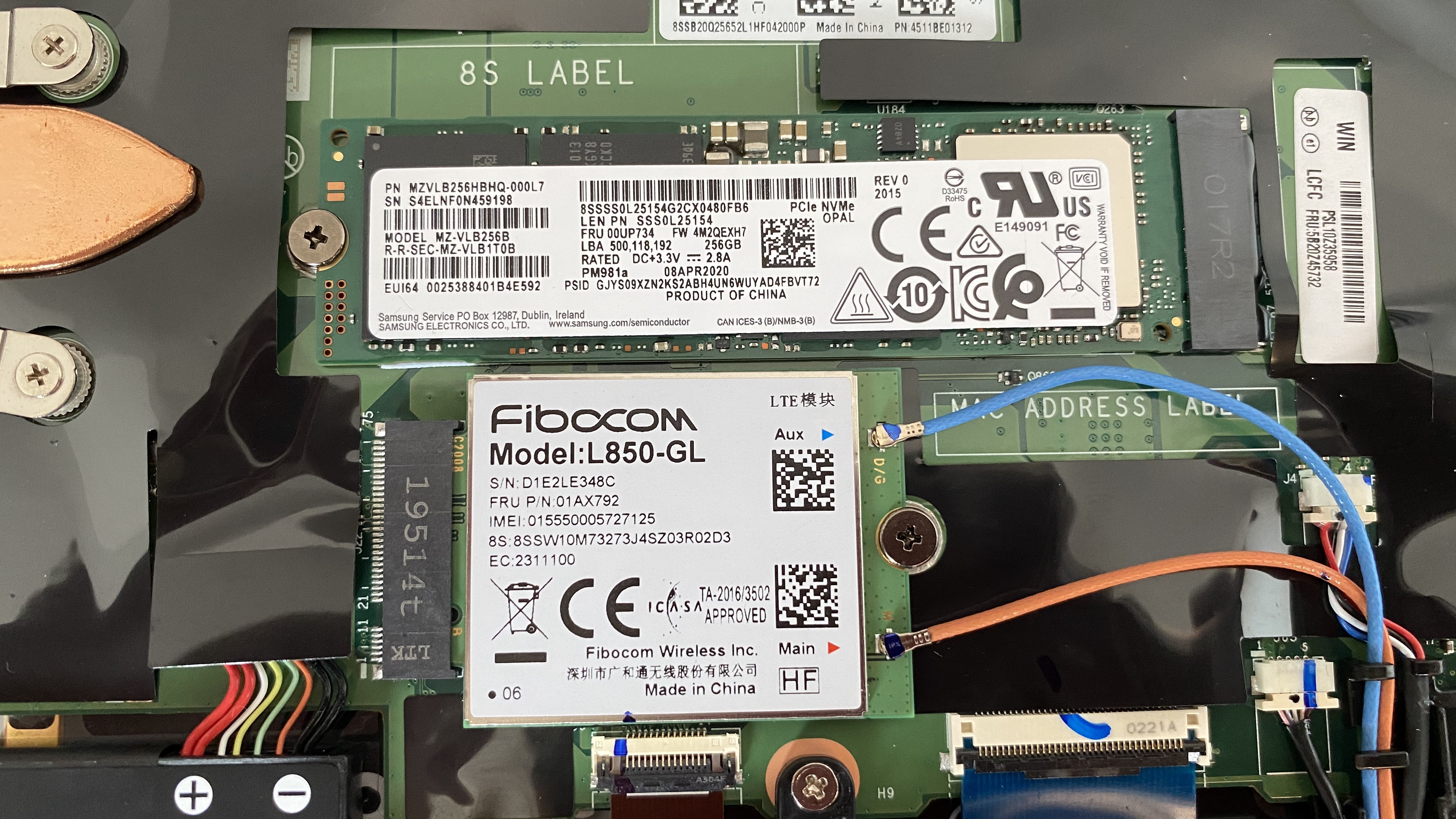
Battery Life of ThinkPad X1 Yoga (Gen 5)
The ThinkPad X1 Yoga (Gen 5) has a large discrepancy in battery life depending on which model you choose, with the FHD model lasting over 4 hours longer than the 4K model in our battery test, which continuously streams video and runs OpenGL tests at 150 nits of brightness.
While the 4K X1 Yoga lasted 7 hours and 27 minutes, the FHD X1 Yoga stuck out for an impressive 11 hours and 30 minutes. That placed the 4K X1 Yoga on the same level as the Yoga C940, which also had a battery life of 7:27, while the FHD X1 Yoga is just behind the Spectre’s 13:19 battery life. The XPS rounded out the middle of the pack with a battery life of 10:57.
Heat on Lenovo ThinkPad X1 Yoga (Gen 5)
Both models of the X1 Yoga remained cool during use, and maintained similar temperatures. After streaming YouTube videos for 15 minutes, both the FHD X1 Yoga and the 4K X1 Yoga registered 94.6 degrees Fahrenheit across the bottom, making it the hottest area on both laptops.
The touchpad was the coolest area, hitting 76.1 degrees Fahrenheit (24.5 degrees Celsius) on the FHD model and 75.9 degrees Fahrenheit (24.4 degrees Celsius) on the 4K model, while the center of the keyboard between the G and H keys hovered in the middle at 84.4 degrees Fahrenheit (29.1 degrees Celsius) on the FHD model and 86.6 degrees Fahrenheit (30.3 degrees Celsius) on the 4K model.
Webcam on ThinkPad X1 Yoga (Gen 5)
The webcams on the ThinkPad X1 Yogas we tested were drastically different across our configurations. While both models come with 720p webcams, our 4K unit’s webcam was significantly brighter and clearer, whether in low-light or high light. I might have believed it were a 1080p camera if you told me; it was that good. The FHD unit’s webcam, to contrast, was more around what I expect from a 720p webcam shooter. Colors were dimmer and there was a bit of a grain to my photos. Both cameras captured texture well.
To make sure the 4K model’s webcam didn’t just look better because of the screen it was displaying on, I also did a second round of testing where I significantly lowered the laptop’s display brightness and made sure HDR was turned off. Even with these handicaps, images still looked more true-to-life here than on the FHD model.
The 4K model also has an IR camera for Windows Hello, so perhaps the 720p sensor that comes with the IR is higher quality.
Regardless of your model, though, you can always up your webcam quality by adding an external webcam like the Logitech c920 or other best webcams contenders.
Software and Warranty of ThinkPad X1 Yoga (Gen 5)
Both models of the X1 Yoga are free of bloatware, aside from typical Windows pack-ins like the Microsoft Solitaire Collection. They do, however, come with a number of helpful productivity apps.
Lenovo Vantage is probably the first of these you’ll notice, since Lenovo ships all ThinkPads with it on the home bar. Vantage consolidates Lenovo’s previous companion, settings and account portal apps into one program, so you can run updates and diagnostics, check Wi-Fi network security, identify serial and product numbers, and disable accessories like the webcam, all in one neat package.
The Lenovo Pen Settings app that comes with all X1 Yoga models lets you map controls and sensitivity for the included pen without needing to wrestle with the more finicky Windows Pen Settings app, while the similarly model-wide Windows Mixed Reality portal lets you control setting for any AR/VR headsets you might own (these, unfortunately, do not ship with the computer).
The FHD X1 Yoga comes with Dolby Access and Dolby Atmos, both of which come with automatic post processing effects for the computer’s audio, including equalizer presets and virtual recreations of surround sound. Dolby Access also links you to a number of media clips for testing your audio setup. The 4K X1 Yoga also has Dolby Atmos, but swaps out Dolby Access for Dolby Vision, which comes with HDR presets like Bright, Dark and Vivid.
Finally, Glance by Mirametrix comes on all X1 Yogas and uses eye tracking to move the mouse cursor and windows across monitors based on where you’re looking, as well as let you know when someone is standing over your shoulder. If these features sound more intrusive than helpful, don’t worry, you can easily ignore them.
The ThinkPad X1 Yoga (Gen 5) comes with a limited one-year warranty.
Configurations of ThinkPad X1 Yoga (Gen 5)
We tested two different custom-built X1 Yogas for this review. The first came with an Intel Core i5-10310U processor, Intel UHD Integrated Graphics, 16GB of DDR3 2133 MHz memory, a 256GB PCIe M.2 SSD and a 14 inch FHD IPS touchscreen Display. The second shared the same memory and graphics, but swapped out the CPU for an Intel Core i7-10610U, upgraded the SSD to 512GB of storage and changed the display to a 14 inch 4K IPS touchscreen.
If you don't buy an X1 Yoga on sale, the ThinkPad tax on both of these is unfortunately here in full force, with our FHD model coming in at $2,724 and our 4k model hitting $3,511. With competitors like the Spectre and the Dell XPS offering similar and sometimes better performance for almost half the price of even our FHD model's MSRP, Lenovo’s asking a lot here, especially with the small storage space. Even the Yoga C940, another Lenovo convertible with performance that rivals the ThinkPads, undercuts it by about half.
There are cheaper models available, but even the starting MSRP is already a steep $2,219, and will only net you an Intel Core i5-10210U processor, 8GB of DDR3 2133 MHz RAM, a 256GB PCIe SSD, and a 14 inch FHD IPS touchscreen.
That said, Lenovo does frequently offer steep sales on its products. When writing this review, two sales passed by that lowered the X1 Yoga's price by up to thousands. Neither was active when we first submitted the review, but one did pop up during edits. Given that frequency, we're willing to bet that you can avoid the ThinkPad tax if you keep an eye on Lenovo's website.
Bottom Line
The ThinkPad X1 Carbon’s speedy SSD, comfortable keyboard and bright display options do give it an edge when it comes to productivity. The X1 Yoga also has a few input device aces up its sleeve in its included stylus, comfortable keyboard and ThinkPad TrackPoint. Its biggest weakness may be its price, which is far higher than competitors when it is not on sale.
If all you care about is performance, last year’s Yoga C940 will give you all that, plus an included stylus of its own. Its SSD isn’t as fast as its ThinkPad cousins and its keyboard isn't as comfortable, but it actually has stronger graphics capabilities and higher Geekbench results. The screen is dimmer, however.
If you want consumer-level prices with a bright screen, the Dell XPS 13 2-in-1 is brighter than even the ThinkPads, while also offering slightly better graphics performance in exchange for a slightly slower SSD. Its 1920 x 1200 display is also slightly higher resolution than you’ll get on a base model X1 Yoga, and the whole laptop is slightly thinner than the ThinkPads, though a few ounces heavier. The HP Spectre x360 13, meanwhile, is even cheaper than both the Yoga C940 and the XPS, in exchange for less performance in certain speed-based processing tasks and a slightly dimmer, less colorful screen. It does, however, have longer battery life than its competitors.
If you’re a ThinkPad fan or a business looking to buy a new fleet of work computers, you’ve probably already made your decision. The all-metal chassis on the X1 Yoga will suit you well, as will the typical ThinkPad niceties like the trackpoint and the physical webcam cover. Its price, even when not on sale, also isn't outrageous for a business computer, especially when compared to other high MSRP rivals like the HP Dragonfly. Business computers often have extra security features and higher durability that companies don't mind paying extra for, and it's not uncommon to get them at a discount when buying a whole fleet.
If you’re an individual looking for a convertible that can go toe-to-toe with the ThinkPad without charging you over $2,000, though, there are rivals that will serve you just as well, even from Lenovo.
Michelle Ehrhardt is an editor at Tom's Hardware. She's been following tech since her family got a Gateway running Windows 95, and is now on her third custom-built system. Her work has been published in publications like Paste, The Atlantic, and Kill Screen, just to name a few. She also holds a master's degree in game design from NYU.
-
nofanneeded Please add 720P camera in cons in every notebook with bad camera until they start respecting us and add 4K webcams (yea not even 1080p) we are living in 2020 !!!Reply
